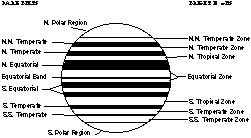This is a drawing of Jupiter's belts and zones.
Click on image for full size
NASA
Jupiter's Belts and Zones
The striped cloud bands on Jupiter are certainly not as straight as they appear to be in this picture!
The picture shows that the striped pattern is divided into belts and zones. The belts and zones of Jupiter are labeled in the picture.
In a belt, the winds flow in one direction. In a zone, the winds blow in the opposite direction. The cloud tops are higher in a belt, and lower in a zone.
Measurements show that the winds of Jupiter, within a belt or a zone are usually 225 miles/hour! These speeds provide for a pretty rough environment.
(Earth has a similar but much weaker pattern of belts and zones.)
You might also be interested in:
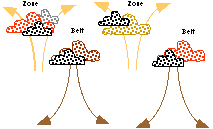
On Jupiter, the winds in the belts and zones blow first in one direction, then in the opposite direction. Wind blows east in a belt, and west in a zone. The clouds rise up in a belt, and drop down in a
...more
Jupiter's atmospheric environment is one of strong gravity, high pressure, strong winds, from 225 miles per hour to 1000 miles per hour, and cold temperatures of -270 degrees to +32 degrees (freezing temperature).
...more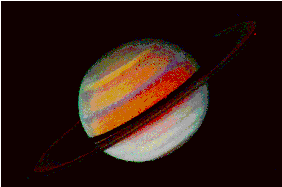
The striped cloud bands on Saturn, like Jupiter, are divided into belts and zones. In a belt, the wind flows very strongly in one direction only. In a zone, the wind flows very strongly in exactly the
...more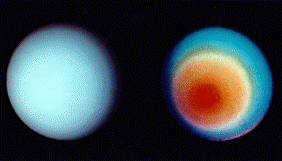
The clouds on Uranus, like Jupiter, are divided into belts and zones. On Uranus the belts and zones are hard to find. The left picture shows the north pole of Uranus. In this picture only the smog of
...more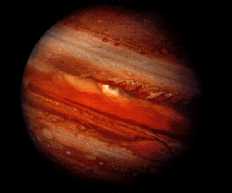
The giant planets have definitely changed since their formation. But how much remains to be seen. Most of the original air of the giant planets remains in place. (The earth-like planets lost most of their
...more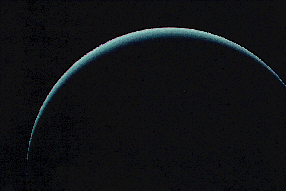
The mesosphere of Jupiter is a region of balance between warming and cooling. That essentially means that nothing happens there. Except for diffusion, the atmosphere is still. Upper reaches of the atmosphere,
...more
As on Earth, the atmosphere of Jupiter consists of a troposphere, stratosphere, mesosphere, and thermosphere. The troposphere is the region where the visible clouds are to be found. The stratosphere, as
...more


